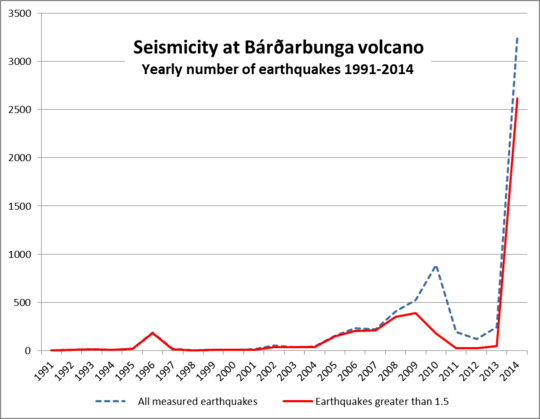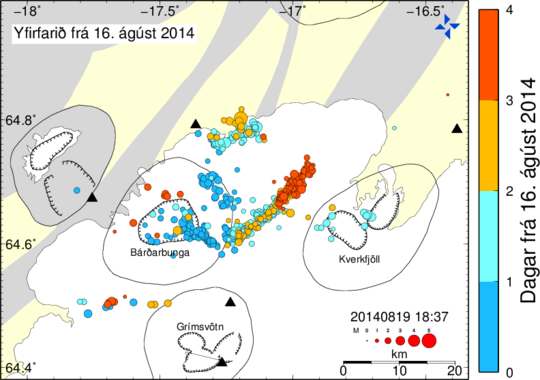From the
Icelandic Meteorological Office:
A summary of seismic activity, written Tuesday evening 19th August 2014 at 20:00

© Wattsupwiththat.com
Around 1.000 small earthquakes were detected in the Bárðarbunga region from midnight (18/19) until Tuesday evening 19th August at 20:00. All of them were smaller than magnitude 3 and most were located in the cluster east of Bárðarbunga.
While the northern cluster close to Kistufell has calmed down significantly following the M4.5 earthquake on early Monday morning, event rates in the eastern cluster are still high. Similar to recent days, two pulses of comparably strong seismic activity have been measured between 04:00 and 08:00 this morning, as well as 16:00 and 18:30 in the afternoon. The cluster east of Bárðarbunga continued to slowly migrate northeastwards today. Events are still located at around 5-12 km depths, no signs of upwards migration has been seen so far.
Below is a summary map of all manually revised earthquakes since the onset of the swarm, which illustrates the migration of earthquake activity during the last days. Earthquakes in the map are colour coded by time, dark blue dots show the onset of the swarm on Saturday, orange dots Tuesday's events until 19:00, light blue and yellow are the days in between. The time scale is days since the onset of the swarm.

© Gunnar B. Guðmundsson, Icelandic Meteorological Office.
via WUWT commenter "unmentionable":
From the quotes below it sound like they're crossing their fingers and toes that this thing stays underground and does not get any bigger. the longer the tremor goes on like this the worse its going to be if it pops under 2,000 ft of water ice.
___
Magma flowing into Bárðarbunga caldera with great force - 20th August 2014
Kristín Vogfjörð, seismologist and research director at the Icelandic Meteorological Office, says that the activity is very powerful. "This just keeps going on. This is many times more powerful than what's been going on in recent years." Kristín says that a large volume of magma is flowing under the caldera, heading northeast towards the Kverkfjöll mountain range. The magma is staying at a depth of 5-10 kilometers - there are no signs of it moving any closer to the surface. If asked if an eruption is due to happen in the next few days, Kristín responds: "Not necessarily. There's nothing suggesting that it's about to. But due to the size and scale of the activity there's full reason to be vigilant and prepare for an eruption."
Magma surge towards the surface would be very powerful - 20th August 2014
Kristín Vogfjörð, research director at the Icelandic Meteorological Office, says that the current seismic activity at Bárðarbunga is many times more powerful than any on record for the site. "It's very powerful," she says. For comparison she notes that thousands of quakes have been measured at Bárðarbunga in the past week, but in the Gjálpar eruption in 1996 they were only a few hundred. ... "While this is going on, it may never reach the surface. But we still need to keep an eye on it because the volume of magma is incredible," she adds. ..."There is no indication that it's moving further up than that.
But if it were to happen, it would happen very quickly," Kristín states.
is that another hockey stick?